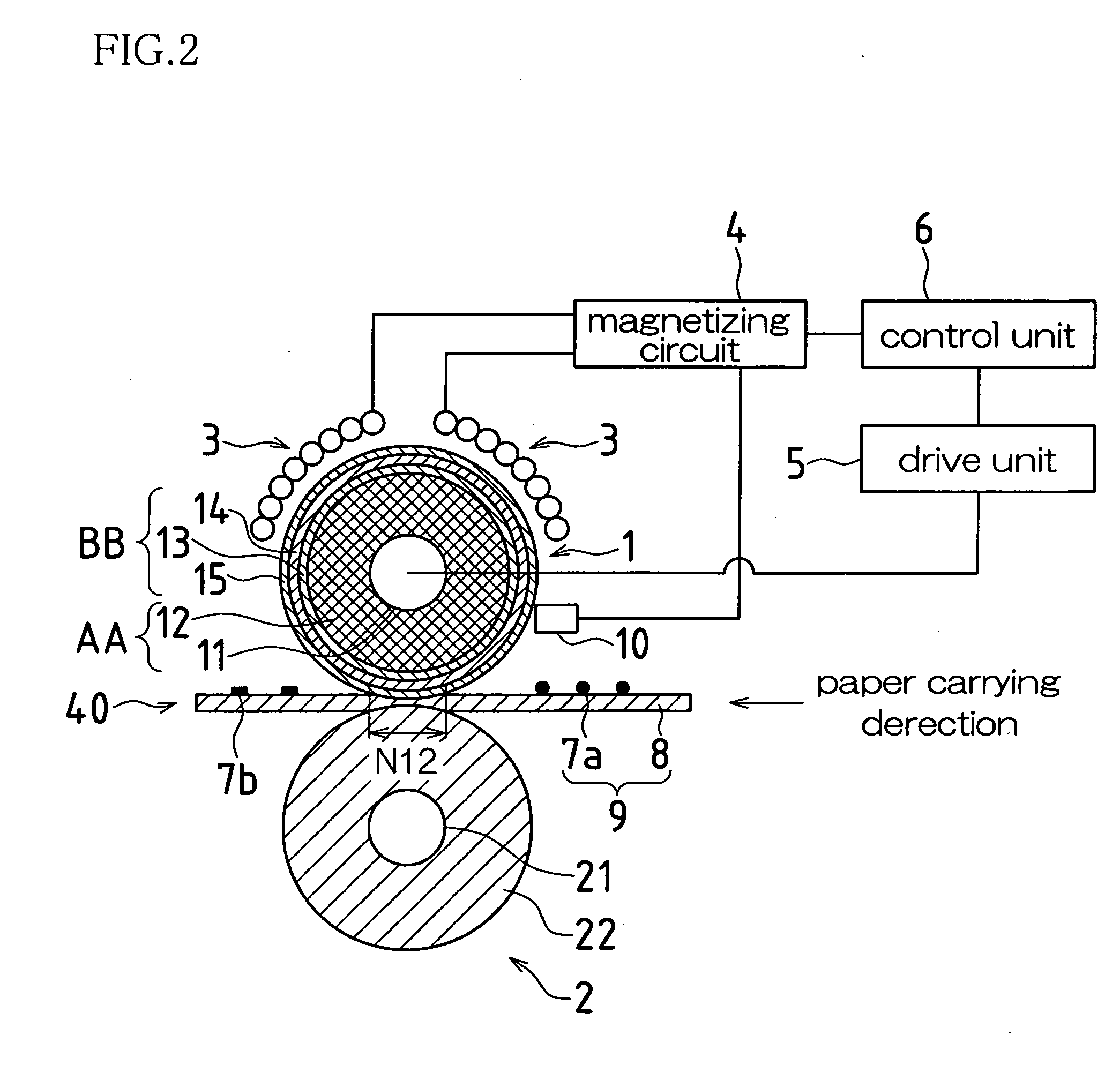Heating roller, heating device and image forming apparatus
a heating device and heat sink technology, applied in the direction of electrographic process apparatus, instruments, optics, etc., can solve the problem of heat loss to the inner portion, and achieve the effect of reducing the warm-up time, facilitating releasability, and efficiently conducting generated hea
- Summary
- Abstract
- Description
- Claims
- Application Information
AI Technical Summary
Benefits of technology
Problems solved by technology
Method used
Image
Examples
working example 1
[0099] An experiment was performed to evaluate the releasability of a fixing device having the above-noted configuration, wherein the conditions of the cylindrical member BB were the same, and wherein only the outer diameter of the elastic roller AA was altered from 38.0 to 40.0 mm.
[0100] Evaluation of the releasability was carried out by passing unfixed image samples, which are described next, through the fixing device. Samples that released without problem from the discharge side (that is, released without winding up on the fixing roller (heating roller) 1) were rated “A”, those that discharged with a tendency to wind up on the fixing roller (heating roller) 1, or in which image defects such as toner peeling occurred were rated “B”, those that wound up on the fixing roller (heating roller) 1 were rated “F”, and samples that released without problem but where the image was hot offset (a phenomenon in which a part of the toner from the recording paper remains on the roller after th...
working example 2
[0113] An experiment was performed to evaluate the releasability of a fixing device having the above-noted configuration, wherein the conditions of the elastic roller AA were the same, and wherein the material of the heat generating layer 13 of the cylindrical member BB was altered from polyimide to nickel (thickness of 40 μm and 30 μm) (however the elastic layer 14 and the release layer 15 were kept the same). The experimental method was the same as in Working Example 1 and is thus omitted.
[0114] When the heat generating layer 13 was nickel with a thickness of 40 μm, the surface hardness t1 of the heating roller 1 was 75° (Asker C), and the hardness differential t3 with the surface hardness (t2=25°) of the elastic roller AA was 50°. On the other hand, the result of a similar measurement when the thickness of the nickel was 30 μm was the surface hardness t1 of the heating roller 1 was 70°, and the hardness differential t3 was 45°. The releasability results taken at this time are sh...
working example 3
[0118] In the present Working Example 3, an experiment was performed with respect to warm-up time, using the image forming apparatus (the present invention) provided with a heating device containing the heating roller of the present invention (constituted by the cylindrical member and the elastic roller, which are capable of separating, wherein a gap (air layer) is formed between the cylindrical member and the elastic roller), and an image forming apparatus (comparative example) that is provided with a heating device containing a conventional heating roller (in which the cylindrical member and the elastic roller are a single piece that cannot be separated).
[0119] In the experiment, the time (s) taken for the surface of the heating roller to achieve a temperature of 170° C. from room temperature was measured under the following conditions:
[0120] Measured Conditions [0121] (1) Power Supply: 1100 W [0122] (2) Rotational Speed: 117 mm / s [0123] (3) Elastic Roller: External Diameter: Ø ...
PUM
 Login to View More
Login to View More Abstract
Description
Claims
Application Information
 Login to View More
Login to View More - R&D
- Intellectual Property
- Life Sciences
- Materials
- Tech Scout
- Unparalleled Data Quality
- Higher Quality Content
- 60% Fewer Hallucinations
Browse by: Latest US Patents, China's latest patents, Technical Efficacy Thesaurus, Application Domain, Technology Topic, Popular Technical Reports.
© 2025 PatSnap. All rights reserved.Legal|Privacy policy|Modern Slavery Act Transparency Statement|Sitemap|About US| Contact US: help@patsnap.com



